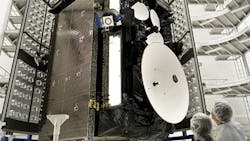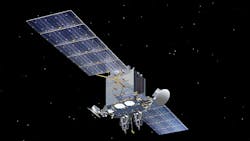Inside the Advanced Extremely High Frequency Satellite Network
The Advanced Extremely High Frequency (AEHF) satellite network has entered its initial operational phase, after completing a series of tests simulating battlefield and cyber-attack situations. Built by Lockheed Martin Space Systems, with Northrop Grumman supplying the antenna payloads, the AEHF network was designed to support protected two-way communications for tactical military forces. With initial tests completed, the system’s international partners—the United States, Canada, the Netherlands, and United Kingdom—will have access to the satellites for military and government operations.
Three nuclear-hardened AEHF satellites are currently in operational orbit. The network was designed with security and signal integrity in mind, insulating communications against jammers, cyber-attacks, and interference. The high data rates and network capacity provide a wide range of services to soldiers and government agents in compatible aircraft, naval vessels, and vehicle. These include data networking, video broadcasting, targeting data, voice conferencing, and strategic report back, among others.
Advantages over Legacy Systems
The AEHF system has significant advantages over its predecessor, the legacy Milstar satellite network. Mark C. Calassa, vice president of protected communications systems at Lockheed Martin, says that the AEHF network transmits data five times faster than legacy satellites and has almost 10 times the capacity. The satellites are designed with an extended data rate (XDR) waveform that pulls transmission speeds up to 8.192 Mbit/s. At the same time, the payloads are backwards-compatible with the Milstar’s low data rate (LDR)—75 to 2400 bit/s—and medium data rate (MDR)—4.8 Kbit/s to 1.544 Mbit/s—waveforms.
The satellites are connected by a series of bidirectional crosslinks, creating an “on-board switchboard in the sky,” as Northrop Grumman phrased it in an article about the AEHF payloads. Exchanging information at 60 Mbit/s, these crosslinks allow the satellite network to process and relay signals directly instead of using vulnerable ground stations. The uplinks and crosslinks operate at 44 GHz in the EHF range, while downlinks operate at 20 GHz in the super-high frequency (SHF) range.
Anti-Jamming and Security Elements
The satellites are equipped with low-noise phased-array antennas, built from more than 10,000 MMICs based on indium-phosphate (InP). Along with flexible channel-to-beam mapping, the antennas direct the signal beams electronically, resulting in high-gain spot beams for unscheduled access for small portable terminals. In addition, two high-resolution antennas support tactical and strategic operations in the presence of in-beam jamming.
The phased-array antennas also help to protect the antenna beams from cyber-attacks and interference. Due to their highly directional nature, the antennas provide jam-resistant communications to ground terminals with a low probability of interception. In addition to frequency-hopping and on-board processing technology, the antennas can change their radiation patterns to guard against potential signal jamming.
Between Initial and Full Operational Capability
The AEHF network is being developed in concert with a highly secure, low-cost terminal (LCT). In August, a research team with members from Lockheed Martin, Telecommunications Systems (TCS), and Northrop Grumman completed a review of the critical security features of the terminal, opening the door for software and hardware to be developed for the end cryptographic unit (ECU). The research team is planning to test the new terminals in late 2015.
The AEHF system will eventually field six satellites. The remaining three modules are expected to launch in 2017, 2018, and 2019, respectively. The expected range of the AEHF system is between the latitudes of 65 deg. north and 65 deg. south. The initial operational capability was reached after a six-month evaluation cycle conducted by the United States Air Force. The team working on the AEHF includes the U.S. Air Force Military Satellite Communications Systems Directorate at the Space and Missile Systems Center in Los Angeles.
About the Author

James Morra
Senior Editor
James Morra is the senior editor for Electronic Design, covering the semiconductor industry and new technology trends, with a focus on power electronics and power management. He also reports on the business behind electrical engineering, including the electronics supply chain. He joined Electronic Design in 2015 and is based in Chicago, Illinois.

